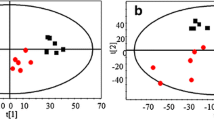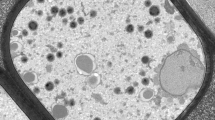Abstract
Lipofuscins of lipidic and proteinaceous origin were identified by their excitation and emission spectra in phytopathogenic fungal representatives of different sclerotial differentiation types. Lipofuscin pigments in Sclerotium rolfsii, Rhizoctonia solani, Sclerotinia minor and Sclerotinia sclerotiorum showed similar excitation and emission maxima (ex-em 330–450, 330–450, 330–470 and 3307–470 nm, respectively). Sclerotial differentiation of these fungi was proceeded by a 4.2, 2.5, 2.7, 2.5 and 6, 2.9, 3.8, 3.1 fold increase of lipofuscin accumulation (per lipid and protein content), per respective fungus, as compared to their undifferentiated stage. Lipofuscin levels were higher in older than in younger mycelia and this phenomenon was more profound in S. rolfsii. Since lipofuscins are considered as indicators of oxidative stress, these data are in accordance with the hypothesis that suggests oxidative stress to be a common underlying factor in sclerotial differentiation of sclerotia-forming filamentous phytopathogenic fungi.
Similar content being viewed by others
References
Wheeler BEJ, Waller JM. The production of sclerotia by Sclerotium rolfsii. II. The relationship between mycelial growth and initiation of sclerotia. Trans Brit Mycol Soc 1965; 48: 303–314.
Geiger JP, Goujon M. Demonstration in mycelial extracts of a morphogenic factor responsible for the appearance of sclerotia of Corticium rolfsii Sacc. C R Acad Sci (Ser. D) 1970; 271: 41–44.
Goujon M. Physiological mechanisms in the formation of sclerotia in Corticium rolfsii (Sacc.) Curzi. Physiologie Vegetale 1970; 8: 349–360.
Georgiou DC. Lipid peroxidation in Sclerotium rolfsii: a new look into the mechanism of sclerotial biogenesis in fungi. Mycol Res 1997; 101: 460–464.
Georgiou DC, Tairis N, Sotiropoulou A. Hydroxyl radical scavengers inhibit lateral-type sclerotial differentiation and growth in phytopathogenic fungi. Mycologia 2000; 92: 825–834.
Georgiou DC, Tairis N, Sotiropoulou A. Hydroxyl radical scavengers inhibit sclerotial differentiation and growth in Sclerotinia sclerotiorum and Rhizoctonia solani. Mycol Res 2000; 104: 1191–1196.
Rana SR, Munkres DK. Ageing of Neurospora crassa. V. Lipid peroxidation and decay of respiratory enzymes in an inositol auxotroph. Mech Ageing De. 1978; 7: 241–272.
Hansberg W, Aguirre J. Hyperoxidant states cause microbial cell differentiation by cell isolation from dioxygen. J Theor Biol 1990; 142: 201–221.
Toledo I, Hansberg W. Protein oxidation related to morphogenesis in Neurospora crassa. Exp Mycol 1990; 14: 184–189.
Hansberg W, De Groot H, Sies H. Reactive oxygen species associated with cell differentiation in Neurospora crassa. Free Rad Biol Med 1993; 14: 287–293.
Lledias F, Rangel P, Hansberg W. Singlet oxygen is part of a hyperoxidant state generated during spore germination. Free Rad Biol Med 1999; 26: 1396–1404.
Toledo I, Noronha-Dutra AA, Hansberg W. Loss of NAD(P)-reducing power and glutathione disulfide excretion at the start of induction of aerial growth in Neurospora crassa. J Bacteriol 1991; 173: 3243–3249.
Yin D. Biochemical basis of lipofusin, ceroid, and age pigment-like fluorophores. Free Rad Biol Med 1996; 21: 871–888.
Thaw HH, Collins PV, Brunk TU. Influence of oxygen tension, pro-oxidants and antioxidants on the formation of lipid peroxidation products (lipofuscin) in individual cultivated human glial cells. Mech Ageing Dev 1984; 24: 211–223.
Harman D. The aging process. Proc Natl Acad Sci USA 1981; 78: 7124–7128.
Fletcher LB, Dillard JC, Tappel LA. Measurement of fluorescent lipid peroxidation products in biological systems and tissues. Anal Biochem 1973; 52: 1–9.
Tsuchida M, Miura T, Mizutani K, Aibara K. Fluorescent substances in mouse and human sera as a parameter of in vivo lipid peroxidation. Biochim Biophys Acta 1985; 834: 196–204.
Gutteridge CMJ, Quinlan JG, Clark I, Halliwell B. Aluminium salts accelerate peroxidation of membrane lipids stimulated by iron salts. Biochim Biophys Acta 1985; 835: 441–447.
Wolff PS, Garner A, Dean TR. Free radicals, lipids and protein degradation. Trends Pharmacol Sci 1986; 11: 27–31.
Esterbauer H, Schaur JR, Zollner H. Chemistry and biochemistry of 4-hydroxynonenal, malonaldehyde and related aldehydes. Free Rad Biol Med 1991; 11: 81–128.
Iio T, Yoden K. Fluorescence formation and heme degradation at different stages of lipid peroxidation. Life Sci 1987; 40: 2297–2302.
Smith TM, Thor H, Hartzell P, Orrenius S. The measurement of lipid peroxidation in isolated hepatocytes. Biochem Pharmacol 1982; 31: 19–26.
Zamora R, Alaiz M, Hidalgo JF. Feed-back inhibition of oxidative stress by oxidized lipid/amino acid reaction products. Biochemistry 1997; 36: 15765–15771.
Willetts JH, Wong LAJ. The biology of Sclerotinia sclerotiorum, S. trifoliorum, and S. minor with emphasis on specific nomenclature. The Bot Rev 1980; 46: 101–165.
Le Tourneau D. Morphology, cytology, and physiology of Sclerotinia species in culture. Phytopathology 1979; 69: 887–890.
Agrios GN. Plant pathology. New York: Academic Press, 1988.
Snyder F, Stephens N. A simplified spectrophotometric determination of ester groups in lipids. Biochim Biophys Acta 1959; 34: 244–245.
Bradford MM. A rapid and sensitive method for quantitation of microgram quantities of protein utilizing the principle of protein-dye binding. Anal Biochem 1976; 72: 248–254.
Minssen M, Munkres DK. Preparation of mitochondrial membrane proteins from Neurospora crassa: Prevention of lipid autoxidation damage by an antioxidant. Biochim Biophys Acta 1973; 291: 398–410.
Munkres DK, Colvin JH. Ageing of Neurospora crassa. II. Organic hydroperoxide toxicity and the protective role of antioxidant and the antioxygenic enzymes. Mech Ageing Dev 1976; 5: 99–107.
Munkres DK. Ageing of Neurospora crassa. IV. Induction of senescence in wild type by dietary amino acid analogs and reversal by antioxidants and membrane stabilizers. Mech Ageing Dev 1976; 5: 171–191.
Author information
Authors and Affiliations
Rights and permissions
About this article
Cite this article
Georgiou, C.D., Zees, A. Lipofuscins and sclerotial differentiation in phytopathogenic fungi. Mycopathologia 153, 203–208 (2002). https://doi.org/10.1023/A:1014988419357
Issue Date:
DOI: https://doi.org/10.1023/A:1014988419357




